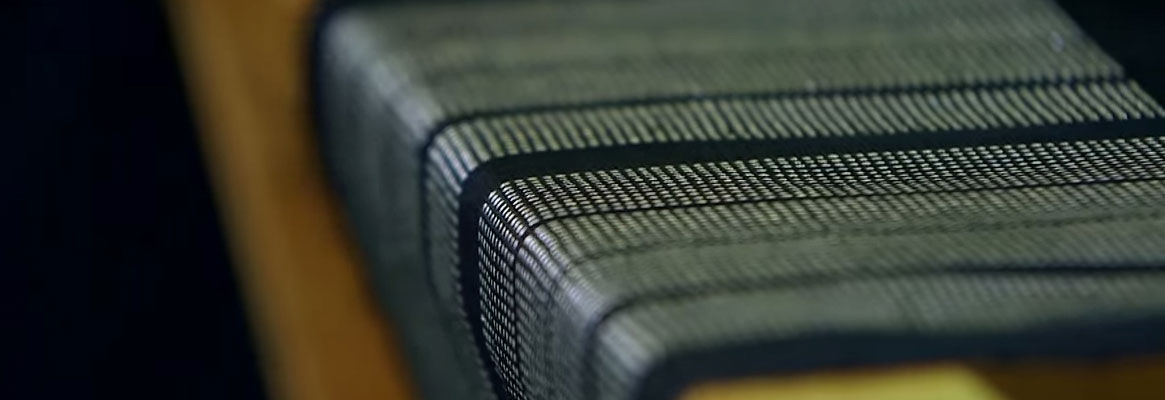M. Janarthanan, G.Krishna Prasad
M.Tech students, Department of Textile Technology,
PSG College of Technology,
Coimbatore-641004
E-Mail: jjjjanatt@yahoo.co.in
C.Dinesh
B.Tech student, Department of Textile Technology,
PSG College of Technology,
Coimbatore-641004.
E-Mail: dinesh_cp2004@yahoo.co.in
ABSTRACT
Intelligent textiles represent the next generation of fibers, fabrics, and articles produced from them. These can be described as textile materials which act by themselves. This means that these may keep us warm in cold environments or cool in hot environments or provide us with considerable convenience, support, and even fun in our normal day-to-day activities, for example, through the incorporation of electronic devices or special colour effects. One of the main reasons for the fast development of intelligent textiles is their importance to the military industry. This is because they are used in different situations such as extreme winter condition, uniforms that change color so as to improve camouflage effects, communication and monitoring of soldiers at warfront.
Keywords: E-textiles, Tents, Wearable Computers, Medical and Aesthetic Textiles, Camouflage.
INTRODUCTION
Intelligent textiles are not confined to the clothing sector only they are becoming increasingly prominent, for example, as biomedical and other engineering materials. It is quite likely that the future developments of intelligent textiles outside the clothing industry may prove to be of real value. Intelligent textiles provide ample evidence of the potential and enormous wealth of opportunities still to be realized in the textile industry, in the fashion and clothing sector, as well as in the technical textiles sector. Intelligent devices will, within the next few years, significantly regulate our day-to-day lives, and many of these devices will be in textiles and clothing.
According to its response textiles can be divided into the following groups
● Passive smart materials, which can only sense the environmental condition or stimuli,
● Active smart materials, which sense and react to the condition or stimuli,
● Very smart materials, which can sense, react and adapt themselves accordingly, and
● Intelligent materials, which are capable of responding or being activated to perform a function in a manual or pre-programmed manner.
INTELLIGENT TECHNOLOGY
A line diagram of intelligent functioning is as follows:
Trigger or stimuli ® Sensing + Processing + Actuation ® Controlling ® Response or Action
The sensors provide a nerve system to detect signals. The processor analyzes and evaluates the signals. The actuators act upon the detected and evaluated signal either directly or from a central control unit. The materials used are photosensitive materials, fiber optics, conductive polymers, thermal sensitive materials, shape memory materials, intelligent coating materials, chemical responsive materials, microcapsules and micro- and nanomaterials. We are inspired to mimic nature in order to create clothing materials with higher levels of functions and smartness. Cloning silk fibers was a first step.
The skin has sensors that can detect pressure, pain, ambient conditions, etc. and can intelligently function with environmental stimuli. Intelligent textiles are materials and structure that sense and react to environmental conditions or stimuli, such as those from mechanical, thermal, chemical, electrical, magnetic or other sources. Intelligent textiles are no longer a science-fiction fantasy. For example, there are in the market self-cleaning carpets, memory-shaped and environment responsive textiles, and anti-insomniac micro-fibers. These “intelligent fabrics” have come about through advances in nano-and micro-engineering-the ability to manipulate and exploit materials at micro or molecular scale. At the nanoscale, materials can be “tuned” to display unusual properties that can be exploited to build faster, lighter, stronger and more efficient devices and systems.
NANOTECHNOLOGY APPLICATIONS IN INTELLIGENT TEXTILES
The textile and clothing industry, normally seen as a ‘traditional industry’, is an important part of the European manufacturing industry and gives employment to over two million people. Increased competition, specifically from Asia, and the proposed abolition of all import quotas for textiles and clothing in the EU, United States, Canada and Norway already is forcing the industry to restructure and modernize. Significant restructuring has taken place over the last decade, however, there is a general recognition that producing traditional apparel products may no longer be sufficient to sustain a viable business, and the EU textile industries may have to move towards more innovative, high quality products in order to differentiate them and compete. Already, nanotechnology is being used to improve the function ability of many consumer products.
Nanotechnology improved products rely on a change in the physical properties when the feature sizes are shrunk.
Multifunctional Textiles
The use of Nanotechnology is allowing textiles to become multifunctional. For instance, Plasma technology is being used to modify the top nanometer layers of textiles, allowing them to be made antibacterial, fungicidal and water repellant. Other areas of interest include heat resistant and mechanically resilient work wear, ballistic protection, sensors and camouflage.
Protective Work Wear
W. L. Gore & Associates ‘Gore-Tex Work wear’ which applies Nanotechnology and Dupont’s?. Teflon to produce an anti-static membrane for protective clothing against bad weather and electrostatic discharges.
Freshness You Can Wear
Nanoparticles have been used to provide the controlled release of fragrances, biocides and antifungal on textiles, leading to the expression, ‘Freshness you can wear’. Ciba Specialty Chemicals (CSC) is modifying fibers on the basis of nanocontainer microcapsules that prevent bacterial growth by releasing antimicrobiotics. The same technology is used to absorb odors.
Improved Moisture Absorption
Kanebo Spinning Corp of Japan has produced a polyester yarn with thirty times the ability of normal polyester to absorb moisture. The yarn, suitable for use in undergarments, has twenty layers for containing moisture and oil content. The layers have a total thickness of fifty nanometers. Toray Industries, Inc. of Japan has developed a fabric containing bundles of ultrafine nanometer nylon threads that allow superior moisture absorption properties.
Intelligent Sensor Textiles
They will look like typical military equipment, such as tents or camouflage nets. The electronic wires and sensors woven into the fabric will perform the complex procedure of listening for the faint sounds of distant vehicles being deployed by the enemy. Within the fabric, the sensors and their connecting wiser will communicate with one another to create patterns of information.
This information can then be translated by computer software into image that will enable soldiers to determine the location of detected sounds. The military already has sound detection systems that rely on radio waves, but communication via radio waves can alert an adversary to a military unit’s location. The e-textiles system being developed produces no detectable energy and also requires less power than radio-wave-operated systems. Fabrics can be woven with sensors that can detect chemicals, pick up satellite signals, and perform other feats.
Wearable Computers
The generic concept of wearable computers is a small CPU in a fanny-pack connected to a cumbersome headgear that holds a display screen at eye-level. Because the wires and sensors in e-textiles are woven into the fabric, wearable computers could be constructed much like normal-looking shirts or hats or other types of cloth apparel. These computers wouldn’t connect users to the Internet or send and receive e-mail, but would perform specific functions necessary to the wearers. Wearable computers constructed of e-textiles after context awareness. They can be designed to be aware of the user’s motions and of his surroundings. Sensors called accelerometers can detect changes in speed and direction. There are visual sensors that can project images to tiny displays clipped to eyeglasses. An e-textile shirt for a blind user might include tiny vibrating motors that would provide cues about approaching objects.
Medical and Aesthetic Applications
Nanoscale titanium dioxide (TiO2) coatings give fabrics antibacterial and anti-odor properties. These have special properties, which can be activated in contact with the air or UV light. Such coatings have already been used to stop socks smelling for instance, to turn airline seats into super stain resistant surfaces, and applied to windows so they clean themselves. Dressings for wounds can now incorporate nanoparticles with biocidal properties and smart patches are being developed to deliver drugs through the skin. Successful experiments have been conducted to grow human nerve cells on circuit boards. This paves the way for brain implants to help paralyzed people interface directly with computers.
Intelligent Clothing for Elderly
Scientists are developing clothes for the elderly that can monitor chronic illness through body temperature, blood pressure, heart rates, breathing and even the way they walk. They dream of garments that can trigger paralyzed limbs to move and that can smooth the motions of patients with Parkinson’s disease or Multiple Sclerosis. Intelligent textiles or “electro textiles” can be described as an amalgamation of two seemingly different fields of textiles and electronics in order to create a new generation of textile structures with electronic capabilities.
Health monitoring vest has been developed for the elderly that can automatically measure and record vital signs, such as heart rate, temperature, and blood pressure. If doctors can evaluate symptoms during normal, everyday activities, then they can make better decisions and more precisely target and monitor the treatment. The development of intelligent textiles are soon going to mix and match sensors, processors, and communications devices that plug into knitted or woven garments made from cotton, polyester, or blends. The garments will be threaded with conductive polymer and metallic fibers that will serve as data buses and power lines. These devices will have the look and feel of typical garments and, after the attachments are unplugged, can be tossed into the washing machine.
New Vision
Intelligent fabrics and textiles will be exploited to enhance functionality, form, or aesthetics. MP3 players–the mass gadget of the moment–will disappear and instead become integrated into one’s clothing. MP3 jackets, based on the idea that electrically conductive fabric can connect to keyboard sewn into sleeves, have already appeared in shops. The textile and clothing industry has been one of the first to exploit Nanotechnology in quite straightforward ways. Many developments are appearing in real products in the fields of medicine, defence, healthcare, sports and communications.
CONCLUSION
Intelligent textiles are not confined to the clothing sector: they are becoming increasingly prominent, for example, as biomedical and other engineering materials. These developments will be the result of active collaboration between people from a whole variety of backgrounds and disciplines: engineering, science, design, process development, and business and marketing. If technology is going to be increasingly part of clothing and skin, there needs to be some serious thinking about what it means for us as humans in future.
REFERENCES
1. Jim Thomas, Nanotech, The Ecologist, February 2004.
2. Jim Thomas, Nanowatch, The Ecologist, May 2004.
3. Louis Theodore, Robert G. Kunz, Nanotechnology: Environmental Implications
and solutions ISBN: 0-471-69976-4
4. Tushar Ghose, Abdelfattah Seyam, and Anuj Dhawab: Electronic Textiles: The Evolution and Future, College of Textiles, NC State University, RALEIGH, NC 27695, U. S. A.
5. ‘Functional textiles’—www.empa.ch
6. ‘Nanotechnology sees payoff in consumer markets’—www.centredaily.com
7. Textiles Intelligence (www.textilesintelligence.com)
To read more articles on Textile, Industry, Technical Textile, Dyes & Chemicals, Machinery, Fashion, Apparel, Technology, Retail, Leather, Footwear & Jewellery, Software and General please visit http://articles.fibre2fashion.com
To promote your company, product and services via promotional article, follow this link: http://www.fibre2fashion.com/services/article-writing-service/content-promotion-services.asp




_Small.jpg)


